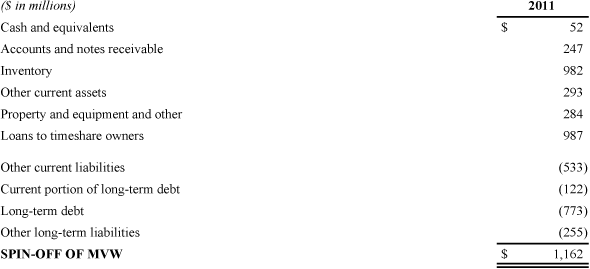Financial Information
16. SPIN-OFF
On November 21, 2011, we completed a spin-off of our timeshare operations and timeshare development business through a special tax-free dividend to our shareholders of all of the issued and outstanding common stock of our then wholly owned subsidiary MVW. Marriott shareholders of record as of the close of business on November 10, 2011 received one share of MVW common stock for every ten shares of Marriott common stock. Neither we nor our shareholders recognize income, gain, or loss for federal income tax purposes as a result of the distribution of MVW common stock, except in the case of our shareholders for cash they received in lieu of fractional shares. As a result of the spin-off, MVW is an independent company whose common shares are listed on the New York Stock Exchange under symbol “VAC,” and we no longer beneficially own any shares of MVW.
In connection with the spin-off, we entered into several agreements with MVW, and, in some cases, certain of its subsidiaries, that govern our post-spin-off relationship with MVW, including a Separation and Distribution Agreement, two License Agreements for the use of Marriott and Ritz-Carlton marks and intellectual property, an Employee Benefits and Other Employment Matters Allocation Agreement, a Tax Sharing and Indemnification Agreement, a Marriott Rewards Affiliation Agreement, and a Non-Competition Agreement. Under license agreements with us, MVW is both the exclusive developer and operator of timeshare, fractional, and related products under the Marriott brand and the exclusive developer of fractional and related products under The Ritz-Carlton brand. Under the license agreements we receive license fees consisting of a fixed annual fee of $50 million plus two percent of the gross sales price paid to MVW for initial developer sales of interest in vacation ownership units and residential real estate units and one percent of the gross sales price paid to MVW for resales of interests in vacation ownership units and residential real estate units, in each case that are identified with or use the Marriott or Ritz-Carlton marks. The license fee also includes a periodic inflation adjustment.
As of the spin-off date, we no longer consolidate MVW’s financial results for periods after the spin-off date as part of our financial reporting. However, because of our significant continuing involvement in MVW operations after the spin-off (by virtue of the license and other agreements between us and MVW), we continue to include our former Timeshare segment’s historical financial results for periods before the spin-off date in our historical financial results as a component of continuing operations.
Our shareholders’ equity decreased by $1,162 million as a result of the spin-off of MVW. We show in the following table the components of the decrease, which was primarily noncash and principally consisted of the net book value of the net assets we contributed to MVW in the spin-off:

For 2011, we recognized $34 million of transaction-related expenses for the spin-off. During the 2011 fourth quarter before the spin-off we also received net cash proceeds of: (1) approximately $122 million from a $300 million secured warehouse credit facility that MVW put in place to provide short-term financing for receivables originated in connection with the sale of timeshare interests, and (2) $38 million from our sale to third-party investors of preferred stock that a subsidiary of MVW issued to us. This distribution of approximately $160 million in cash before completion of the spin-off had no impact on our earnings.
Before the spin-off, management assessed the Timeshare segment’s intended use of excess undeveloped land and built inventory and the then current market conditions for those assets. On September 8, 2011, management approved a plan for our former Timeshare segment to accelerate cash flow through the monetization of certain excess undeveloped land in the U.S., Mexico, and the Bahamas over the next 18 to 24 months and to accelerate sales of excess built luxury fractional and residential inventory over the next three years. As a result, under the guidance for accounting for the impairment or disposal of long-lived assets, because the nominal cash flows from the planned land sales and the estimated fair values of the land and excess built luxury inventory were less than their respective carrying values, we recorded a pre-tax noncash impairment charge of $324 million ($234 million after-tax) in our 2011 Income Statement under the “Timeshare strategy-impairment charges” caption which we allocated to our former Timeshare segment. The pre-tax noncash impairment charge consisted of a $256 million inventory impairment and a $68 million property and equipment impairment.
We estimated the fair value of the land by using recent comparable sales data for the land parcels, which we determined were Level 3 inputs. We estimated the fair value of the excess built luxury fractional and residential inventory using cash flow projections discounted at risk premiums commensurate with the market conditions of the related projects. We used Level 3 inputs for these discounted cash flow analyses and our assumptions included: growth rate and sales pace projections, additional sales incentives such as pricing discounts, and marketing and sales cost estimates.
Please see Footnote No. 18, “Timeshare Strategy-Impairment Charges” of the Notes to our Financial Statements in our 2011 Form 10-K for more information on these charges.
